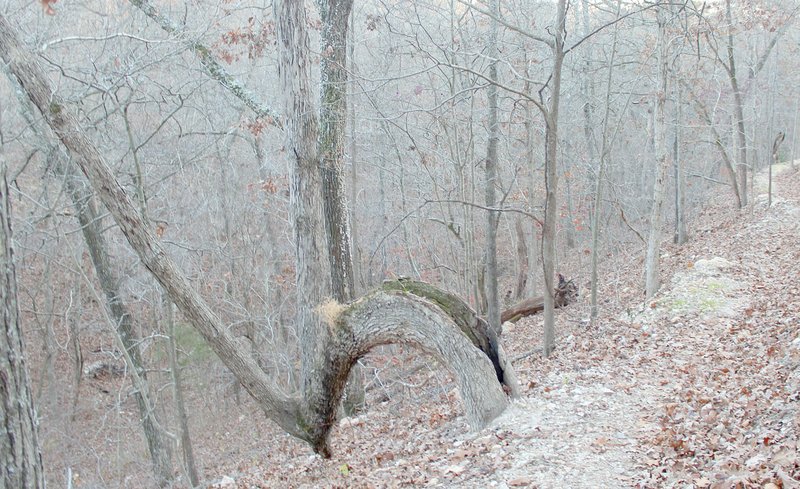There's a trio of strange trees tucked away alongside the freshly-carved Back 40 trail system that appear to be human-modified, much like native American trail marker trees, though an expert doubts they're the real deal.
Mike Rush, proprietor of Rush Running, said he noticed the trees while he was exploring the trails, shortly before the system was finished.
These trees have a distinctive shape, with a curve sprouting from the ground, only to give way to a sharp angle with one thick limb going mostly straight up.
Rush said there isn't really agreement on what each tree means, but, typically, native American trees are pointing to a water source or boundary line, or otherwise serving as some sort of sign.
These trees are modified, he said, by tying a sapling down with a bit of leather or rope, possibly even a vine. This, he said, forces it to curve, and then the very top of it is lopped off. This causes a branch to grow straight up, he said, becoming the tree's main growth, while the cut end forms into a nub.
"We're actually doing one at my house to show my kids how they did it," Rush said.
The trail, he said, just happened to get cut next to three of them. One is on the Main Loop, south of Grosvenor Road and near the power station. Another sits alongside the SBAT trail a short distance south of Bedford Lane. The third rests inside a switchback on the Main Loop, just north of Commonwealth Road.
Dennis Downes, who has studios in Antioch, Ill., and Chicago, is the author of "Native American Trail Marker Trees: Marking Paths through the Wilderness." He's logged well over half a million miles researching trail marker trees nationwide for 30 years, he said.
Downes said that he does not believe these trees were bent by native Americans.
"I've been doing this basically my entire adult life," he said. "And they are small to be shaped by actual native Americans."
Downes said that, in this area, a tree old enough to have been shaped by native Americans would likely be 150 to 200 years old, with a typical diameter of 30 inches. The largest of the trees Rush found was the one on SBAT, which measured at 16.5 inches in diameter.
Sometimes a tree falling on a sapling will produce a similar result, he said, but these could still be man-made.
"In the late 1800s and early 1900s there was a big resurgence," Downes said. "It was shared across the country, which also spurred people to imitate them. There's nothing wrong with that."
Downes said he has made trail trees himself as part of his exploration of the practice. It's amazing, he said, to spend a short time creating something that can last for centuries. He has an immense appreciation for the technique, he said, for its cleverness in addition to it being one of the earliest green techniques.
But there is a problem with identifying trail trees incorrectly, he said, because it's presenting a nontruth.
"Why I work with the native Americans so well is I don't make stuff up," Downes said. "It's not the amount of trail marker trees people find, it's not a contest."
There are several of these trees in Arkansas, he said, and he's been to the state on numerous occasions to document them.
Arkansans interested in looking at trail trees made by native Americans, he said, should head out to Hobbs State Park-Conservation Area, where several examples can be seen.
In addition to his book, which contains a significant amount of his work -- which has continued since the volume's publication in 2011 -- Downes has published information and photos on his website, downesstudio.net.
While Downes has shared his thoughts on the origins of these strange trees along the Back 40, Mike Rush isn't convinced.
"He needs to come down here and see them," Rush said.
General News on 12/28/2016
